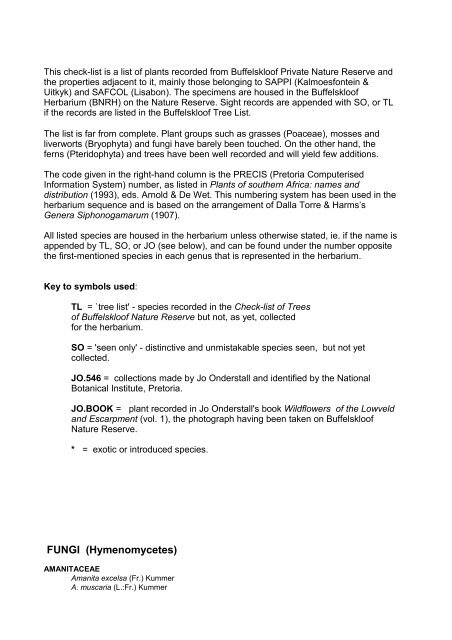the Flora of Buffelskloof Nature Reserve - Buffelskloof Private Nature ...
the Flora of Buffelskloof Nature Reserve - Buffelskloof Private Nature ...
the Flora of Buffelskloof Nature Reserve - Buffelskloof Private Nature ...
You also want an ePaper? Increase the reach of your titles
YUMPU automatically turns print PDFs into web optimized ePapers that Google loves.
This check-list is a list <strong>of</strong> plants recorded from Buffelsklo<strong>of</strong> <strong>Private</strong> <strong>Nature</strong> <strong>Reserve</strong> and<br />
<strong>the</strong> properties adjacent to it, mainly those belonging to SAPPI (Kalmoesfontein &<br />
Uitkyk) and SAFCOL (Lisabon). The specimens are housed in <strong>the</strong> Buffelsklo<strong>of</strong><br />
Herbarium (BNRH) on <strong>the</strong> <strong>Nature</strong> <strong>Reserve</strong>. Sight records are appended with SO, or TL<br />
if <strong>the</strong> records are listed in <strong>the</strong> Buffelsklo<strong>of</strong> Tree List.<br />
The list is far from complete. Plant groups such as grasses (Poaceae), mosses and<br />
liverworts (Bryophyta) and fungi have barely been touched. On <strong>the</strong> o<strong>the</strong>r hand, <strong>the</strong><br />
ferns (Pteridophyta) and trees have been well recorded and will yield few additions.<br />
The code given in <strong>the</strong> right-hand column is <strong>the</strong> PRECIS (Pretoria Computerised<br />
Information System) number, as listed in Plants <strong>of</strong> sou<strong>the</strong>rn Africa: names and<br />
distribution (1993), eds. Arnold & De Wet. This numbering system has been used in <strong>the</strong><br />
herbarium sequence and is based on <strong>the</strong> arrangement <strong>of</strong> Dalla Torre & Harms’s<br />
Genera Siphonogamarum (1907).<br />
All listed species are housed in <strong>the</strong> herbarium unless o<strong>the</strong>rwise stated, ie. if <strong>the</strong> name is<br />
appended by TL, SO, or JO (see below), and can be found under <strong>the</strong> number opposite<br />
<strong>the</strong> first-mentioned species in each genus that is represented in <strong>the</strong> herbarium.<br />
Key to symbols used:<br />
TL = `tree list' - species recorded in <strong>the</strong> Check-list <strong>of</strong> Trees<br />
<strong>of</strong> Buffelsklo<strong>of</strong> <strong>Nature</strong> <strong>Reserve</strong> but not, as yet, collected<br />
for <strong>the</strong> herbarium.<br />
SO = 'seen only' - distinctive and unmistakable species seen, but not yet<br />
collected.<br />
JO.546 = collections made by Jo Onderstall and identified by <strong>the</strong> National<br />
Botanical Institute, Pretoria.<br />
JO.BOOK = plant recorded in Jo Onderstall's book Wildflowers <strong>of</strong> <strong>the</strong> Lowveld<br />
and Escarpment (vol. 1), <strong>the</strong> photograph having been taken on Buffelsklo<strong>of</strong><br />
<strong>Nature</strong> <strong>Reserve</strong>.<br />
* = exotic or introduced species.<br />
FUNGI (Hymenomycetes)<br />
AMANITACEAE<br />
Amanita excelsa (Fr.) Kummer<br />
A. muscaria (L.:Fr.) Kummer


